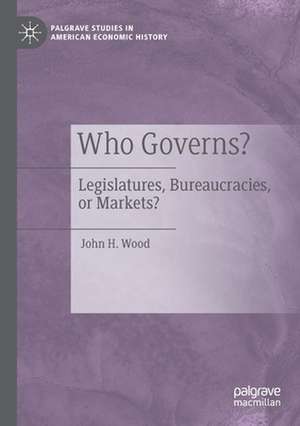Who Governs?: Legislatures, Bureaucracies, or Markets?: Palgrave Studies in American Economic History
Autor John H. Wooden Limba Engleză Paperback – 29 ian 2021
This book examines US economic history to demonstrate how the applications of laws are uncertain, affected by changing political and economic conditions as well as by legislators’ perceptions and the ability or willingness of bureaucracies to enforce laws. The two cases developed in this book revolve around William McChesney Martin, Jr., who helped apply (i) the 1930s Securities Acts as president of the New York Stock Exchange and (ii) the Federal Reserve Act in the Keynesian era unforeseen by that Act. As chairman of the New York Stock Exchange, Martin served as private regulator of firms listed on the Exchange—itself a publicly regulated entity. As chairman of the Federal Reserve, he then served as a public regulator. This book thus offers an innovative approach to understanding and examining the various issues and incentives facing each of the three parties: regulated, private regulator, and public regulator.
| Toate formatele și edițiile | Preț | Express |
|---|---|---|
| Paperback (1) | 694.22 lei 6-8 săpt. | |
| Springer International Publishing – 29 ian 2021 | 694.22 lei 6-8 săpt. | |
| Hardback (1) | 699.45 lei 6-8 săpt. | |
| Springer International Publishing – 29 ian 2020 | 699.45 lei 6-8 săpt. |
Preț: 694.22 lei
Preț vechi: 816.73 lei
-15% Nou
Puncte Express: 1041
Preț estimativ în valută:
132.84€ • 144.75$ • 111.94£
132.84€ • 144.75$ • 111.94£
Carte tipărită la comandă
Livrare economică 23 aprilie-07 mai
Preluare comenzi: 021 569.72.76
Specificații
ISBN-13: 9783030330859
ISBN-10: 3030330850
Pagini: 274
Ilustrații: IX, 274 p. 8 illus.
Dimensiuni: 148 x 210 mm
Greutate: 0.35 kg
Ediția:1st ed. 2020
Editura: Springer International Publishing
Colecția Palgrave Macmillan
Seria Palgrave Studies in American Economic History
Locul publicării:Cham, Switzerland
ISBN-10: 3030330850
Pagini: 274
Ilustrații: IX, 274 p. 8 illus.
Dimensiuni: 148 x 210 mm
Greutate: 0.35 kg
Ediția:1st ed. 2020
Editura: Springer International Publishing
Colecția Palgrave Macmillan
Seria Palgrave Studies in American Economic History
Locul publicării:Cham, Switzerland
Cuprins
1. Introduction.- 2. The Securities Act of 1933.- 3. Bureaucracies.- 4. The NYSE and the SEC.- 5. Central Banking in the United States.- 6. Chairman of the Fed.- 7. So Who Governs?.
Notă biografică
John H. Wood is Reynolds Professor of Economics at Wake Forest University, USA.
Textul de pe ultima copertă
When we start to perceive that there is a problem in the market (such as monopoly, fraud or speculation), the legislature passes a law to correct it, a bureaucracy is created to interpret and enforce the new law, firms and other market participants comply, and the problem is solved. But is it? Are politicians’ promises and textbooks’ stories to be believed?
This book examines US economic history to demonstrate how the applications of laws are uncertain, affected by changing political and economic conditions as well as by legislators’ perceptions and the ability or willingness of bureaucracies to enforce laws. The two cases developed in this book revolve around William McChesney Martin, Jr., who helped apply (i) the 1930s Securities Acts as president of the New York Stock Exchange and (ii) the Federal Reserve Act in the Keynesian era unforeseen by that Act. As chairman of the New York Stock Exchange, Martin served as private regulator of firms listed on the Exchange—itself a publicly regulated entity. As chairman of the Federal Reserve, he then served as a public regulator. This book thus offers an innovative approach to understanding and examining the various issues and incentives facing each of the three parties: regulated, private regulator, and public regulator.
This book examines US economic history to demonstrate how the applications of laws are uncertain, affected by changing political and economic conditions as well as by legislators’ perceptions and the ability or willingness of bureaucracies to enforce laws. The two cases developed in this book revolve around William McChesney Martin, Jr., who helped apply (i) the 1930s Securities Acts as president of the New York Stock Exchange and (ii) the Federal Reserve Act in the Keynesian era unforeseen by that Act. As chairman of the New York Stock Exchange, Martin served as private regulator of firms listed on the Exchange—itself a publicly regulated entity. As chairman of the Federal Reserve, he then served as a public regulator. This book thus offers an innovative approach to understanding and examining the various issues and incentives facing each of the three parties: regulated, private regulator, and public regulator.
Caracteristici
Contributes to the literature on the behavior of bureaucracies, the effectiveness of financial regulation, and Federal Reserve conduct Uses William McChesney Martin, Jr.'s conduct as president of the New York Stock Exchange and Chairman of the Federal Reserve as case studies Questions the extent to which legislative acts designed to regulate business achieve their goals






